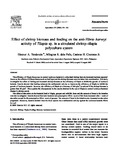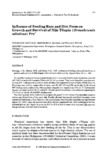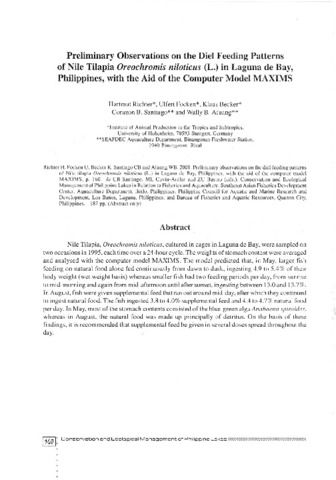Nutrition and feeds of Nile tilapia broodstock and fry
Share
Abstract
Studies on some aspects of tilapia and feed formulation conducted at BRS are reviewed in this paper.
The effect fo varying dietary crude protien on growth and spawning frequency of tilapia was determined under laboratory conditions. The weight of male fish increased as dietary crude protein increased; however, weight gain of male fish did not follow a definite due to the asynchronous nature of spawning of the tilipia. Results suggested that when diets contain high-quality protein, and feedig is at station level, the influence of increasing dietary protein on spawning frequency and growth of the females are not cxonsiderable.
In another study, tilapia broodstock in cages and tanks had the best growth and highest fry production when fed a 40% CP diet.
Ipil-ipil leaf mal as a sole or major source of dietary protein caused weight loss among tilapia breeders, drastic reduction in fry production, and eventually cessation of reproduction. The growth of breeders describers decreased significantly with the incorpotion of more than 40% ipil-ipil in the diet.
For Nile tilapia fry, growth was enhanced by availability of high phytoplankton densities in the rearing medium through the culture period. Feeding the fry with unialgal culture of Navicula and Chroococcus resulted in highest gains and survival rates. Chlorella gave poor survival and growth. Rice bran or Moina as feed for the fry was nutritionally inadequate. Their nutritional value improved when both were combined as feed.
Suggested Citation
Santiago, C. B. (1989). Nutrition and feeds of Nile tilapia broodstock and fry. In R. D. Fortes, L. C. Darvin, & D. L. de Guzman (Eds.), Fish and crustacean feeds and nutrition : Proceedings of the seminar-workshop on fish and crustacean feeds and nutrition held on 25-26 February 1985 at UPV, Iloilo City (pp. 40-49). Laguna, Philippines: Philippine Council for Aquatic and Marine Research and Development.
Subject
Collections
Related items
Showing items related by title, author, creator and subject.
-
Effect of shrimp biomass and feeding on the anti-Vibrio harveyi activity of Tilapia sp. in a simulated shrimp–tilapia polyculture system
Tendencia, Eleonor; dela Peña, Milagros R.; Choresca, Casiano H., Jr. (Elsevier, 2006)The efficiency of Tilapia hornorum to control luminous bacteria in a simulated shrimp farm environment has been reported. However, the effects of different factors such as feed input and the shrimp biomass were not taken ... -
Influence of feeding rate and diet form on growth and survival of Nile tilapia (Oreochromis niloticus) fry
Santiago, Corazon B; Aldaba, Mercedes B.; Reyes, Ofelia S. (Elsevier, 1987)Young Nile tilapia (12 mg mean body weight and 11 mm total length) were stocked at a density of 5 fish/l in twelve 50-l aquaria filled with 30 l of tap water. They were fed pellet crumbles containing 35% crude protein at ... -
Preliminary observations on the diel feeding patterns of Nile tilapia Oreochromis niloticus (L.) in Laguna de Bay, Philippines, with the aid of the computer model MAXIMS
Richter, Hartmut; Focken, Ulfert; Becker, Klaus; Santiago, Corazon B.; Afuang, Wally B. (Aquaculture Department, Southeast Asian Fisheries Development Center; Philippine Council for Aquatic and Marine Research and Development (PCAMRD), Department of Science and Technology; Bureau of Fisheries and Aquatic Resources, 2001)Nile Tilapia, Oreochromis niloticus, cultured in cages in Laguna de Bay, were sampled on two occasions in 1995, each time over a 24-hour cycle. The weights of stomach content were averaged and analysed with the computer ...




